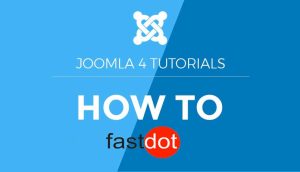Joomla‘s Administration Interface is a web-based, user-friendly platform that allows website owners to manage their Joomla websites efficiently. It provides a comprehensive set of tools and features to control, monitor, and update various aspects of a Joomla website. This powerful interface is essential for creating and maintaining a successful website. Let us take a closer look at its key components.
- Control Panel: The control panel is the central hub of Joomla’s Administration Interface. It provides quick access to the most commonly used features and tools, making website management more efficient.
- Menu Manager: This component allows you to create and manage the menus on your website. It also lets you organize menu items and assign them to different pages or sections of your website.
- User Manager: As the name suggests, this tool helps you manage user accounts and their permissions on your website. You can add, edit, and delete users, as well as assign specific roles and permissions to them.
- Article Manager: This component allows you to create and manage articles on your website. You can organize them into different categories and assign them to different menus.
- Media Manager: This tool helps you manage the media files on your website, including images, videos, and documents. You can upload, organize, and insert media files into your web pages directly from this manager.
- Extension Manager: This component allows you to install, update, and manage extensions on your Joomla website. You can easily add new features and functionalities to your site by installing extensions from the official Joomla Extensions Directory.
- Global Configuration: This section allows you to configure various global settings for your website, such as site name, metadata, caching, and SEO.
- Template Manager: This tool allows you to manage the appearance of your website by installing, editing, or changing templates. You can also create your own custom templates using this manager.
- Language Manager: Joomla supports multiple languages, and the Language Manager helps you manage the installed languages on your site. You can add or remove languages and change the default language for your website.
- Help Menu: This menu provides access to Joomla’s official documentation, forums, and support resources, making it easier to find solutions to any issues or questions you may have.
To access Joomla’s Administration Interface, simply log in to the backend of your website using the username and password you set during the installation process.
The benefits of using Joomla’s Administration Interface include a user-friendly interface, customization options, efficient content management, easy extension installation, and multi-language support. This interface empowers website owners to manage their Joomla websites effectively and make the most out of its features and functionalities.
Table of Contents
- 1 Key Takeaways:
- 2 What are the Key Components of Joomla’s Administration Interface?
- 3 How to Access Joomla’s Administration Interface?
- 4 What are the Benefits of Using Joomla’s Administration Interface?
- 5 Frequently Asked Questions
- 5.1 What are the key components of Joomla’s administration interface?
- 5.2 What is the purpose of the administrator part in Joomla’s administration interface?
- 5.3 How does the site part of Joomla’s administration interface function?
- 5.4 What are some recommended resources for learning about Joomla component development?
- 5.5 What is the purpose of SEF routing in Joomla’s administration interface?
- 5.6 How should a Joomla component be constructed properly?
Key Takeaways:
error
What are the Key Components of Joomla’s Administration Interface?
When it comes to managing your Joomla website, the administration interface is where all the magic happens. But what exactly does this interface consist of? In this section, we’ll take a closer look at the key components of Joomla’s administration interface. From the control panel to the help menu, each element plays a crucial role in managing your website efficiently. So let’s dive in and explore the various tools and features that make up Joomla’s administration interface.
1. Control Panel
The Control Panel is a crucial element of Joomla’s Administration Interface, providing access to various management features. Here are the steps to access and utilize the Control Panel:
- Log in to the Joomla administration area using your credentials.
- Click on the “Control Panel” option in the main dashboard.
- From the Control Panel, you can manage key aspects like articles, menus, users, extensions, and more.
- Navigate through the Control Panel to perform actions such as creating new articles, managing user permissions, or configuring global settings.
- Utilize the search and filter functions within the Control Panel to quickly find specific items or perform bulk actions.
- Regularly check the Control Panel for system updates, notifications, and important messages.
By effectively utilizing the Control Panel, you can streamline your Joomla website management and optimize its performance. Stay organized, keep track of important activities, and make the most out of Joomla’s powerful administration capabilities.
2. Menu Manager
The Menu Manager in Joomla’s Administration Interface allows users to effectively manage the navigation structure and menus of their website. Here is a step-by-step guide on how to use the Menu Manager:
- Log in to Joomla’s Administration Interface with your credentials.
- Click on the “Menus” option in the main navigation menu.
- Select the desired menu to manage.
- Click on “Add New Menu Item” to create a new menu item.
- Choose the type of menu item and provide the necessary details.
- Customize the menu item’s settings, including access levels and page parameters.
- Reposition menu items by dragging and dropping them.
- Use the “Trash” button to delete any unwanted menu items.
- Save your changes and preview the updated menu on your website.
With the Menu Manager, you can easily create and organize your website’s menu structure, providing a seamless navigation experience for your visitors.
3. User Manager
The User Manager is an essential component of Joomla’s Administration Interface, enabling administrators to efficiently manage user accounts and permissions. Here is a list of steps to effectively use the User Manager:
- Login to the Joomla Administration Interface.
- Click on the “Users” tab in the top menu.
- From the drop-down menu, select “User Manager.”
- Here, you can view and manage existing users, as well as create new user accounts.
- Edit user details, such as username, password, and email address.
- Assign user groups and set permissions for each user.
- Enable or disable user accounts as needed.
- Utilize the search function to quickly find specific users.
- Sort and filter users based on various criteria.
- Take advantage of bulk actions to modify multiple user accounts at once.
By utilizing the User Manager, administrators can maintain an organized and secure user system within their Joomla website.
4. Article Manager
The Article Manager is a crucial element of Joomla’s Administration Interface, providing efficient management of content. To effectively use the Article Manager, follow these steps:
- Login to Joomla’s Administration Interface.
- Click on “Content” in the top menu.
- Select “Article Manager” to access the list of existing articles.
- To create a new article, click on “New” and enter the article details.
- Manage existing articles by editing, publishing, or unpublishing them.
- Organize articles into categories and assign tags for easy navigation.
- Use the search function to find specific articles quickly.
- Apply filters to sort articles based on various criteria, such as date or author.
- Utilize the bulk actions feature to perform actions on multiple articles simultaneously.
- Remember to regularly backup articles to prevent any data loss.
By following these steps, you can effectively manage your articles using Joomla’s Article Manager. Make sure to regularly update and optimize your content for better website performance and user experience.
5. Media Manager
Joomla’s Media Manager is an essential part of its Administration Interface, providing efficient management of multimedia files on your website. To utilize the Media Manager, follow these simple steps:
- Login to your Joomla administration panel.
- Navigate to the “Content” menu and select “Media Manager.”
- You can easily upload new media files by clicking the “Upload” button.
- To edit or delete existing media files, simply select the file and choose the appropriate action from the toolbar.
- Organize your media files by creating folders with the “New Folder” button.
- Efficiently search for specific media files using the search feature.
6. Extension Manager
The Extension Manager in Joomla’s Administration Interface allows users to easily install, update, and manage extensions. Here are the steps to utilize this feature:
- Login to the Joomla Administration Interface.
- Go to the “Extensions” menu and select “Manage” to access the Extension Manager.
- Click on the “Install” tab to install new extensions.
- Choose the installation type, either from a file or directly from a URL.
- Upload the extension file or enter the URL and click on “Install” to proceed.
- After installation, the Extension Manager will list the newly added extension.
- To update an extension, go to the “Update” tab and click on “Find Updates”.
- Select the desired extension and click on “Update” to complete the process.
- You can also uninstall and manage extensions using the appropriate tabs in the Extension Manager.
In true history, Joomla’s Extension Manager has been a crucial tool for website administrators since its introduction, simplifying the management of extensions and enhancing the functionality of Joomla-powered websites.
7. Global Configuration
The Global Configuration feature in Joomla’s Administration Interface allows users to customize and manage various settings for their website. Here are the steps to access and utilize the Global Configuration:
- Login to the Joomla Admin Panel using your credentials.
- Click on the “System” menu and select “Global Configuration”.
- In the Global Configuration screen, you can modify settings related to site details, SEO, caching, database, and more.
- Customize parameters like site name, metadata, timezone, default editor, and error reporting.
- Configure caching options to improve site performance.
- Adjust database settings for efficient management.
- Save your changes and your new configurations will be applied to your Joomla website.
8. Template Manager
The Template Manager found in Joomla’s Administration Interface allows you to easily manage and customize the appearance of your website. Follow these steps to access and utilize the Template Manager:
- Login to the Joomla Admin Dashboard
- Click on “Extensions” in the top menu
- Select “Templates” from the dropdown menu
- In the Template Manager, you can view and manage the installed templates
- To customize a template, click on the template name
- Here, you can modify the template’s style, layout, and settings
- Save your changes and view the updated template on your website
- You can also install new templates using the Extension Manager
- Upload the template file and activate it in the Template Manager
- Manage multiple templates for different pages or sections of your site
By utilizing the Template Manager, you can easily control the visual aspects of your Joomla website and create a unique and professional design.
9. Language Manager
The Language Manager is a vital feature of Joomla’s Administration Interface, providing users with the ability to manage and personalize the language settings of their website. To effectively access and utilize the Language Manager, follow these steps:
- Login to the Joomla Administration Interface.
- Click on “Extensions” in the top menu and select “Language Manager” from the dropdown.
- In the Language Manager, you can view and manage the installed languages, including their details and associations with specific extensions.
- To add a new language, click on the “Content” tab and then “Languages”.
- Select the desired language from the list or upload a language pack.
- Set the default language and adjust any other necessary language settings.
- You can also edit language overrides or create custom language strings for your website.
- Save the changes and your language settings will be applied to your Joomla website.
10. Help Menu
- The Help Menu in Joomla’s Administration Interface provides access to comprehensive documentation and support resources.
- To access the Help Menu, login to the Joomla admin interface and click on the “Help” button located in the top right corner.
- Clicking on the Help button will open a dropdown menu with options to access various resources.
- You can find links to the official Joomla documentation, community forums, video tutorials, and more.
- The Help Menu is a valuable tool for getting answers to questions, troubleshooting issues, and learning more about Joomla’s features and functionality.
Fun fact: Did you know that Joomla is one of the most popular content management systems globally, powering millions of websites? It’s known for its flexibility, user-friendly interface, and extensive community support.
How to Access Joomla’s Administration Interface?
To access Joomla’s administration interface, follow these steps:
- Open your web browser and enter the URL of your Joomla website.
- Add “/administrator” to the end of the URL and press Enter.
- You will be redirected to the login page of the Joomla administration interface.
- Enter your username and password in the respective fields.
- Click on the “Log in” button to access the Joomla administration interface.
What are the Benefits of Using Joomla’s Administration Interface?
Joomla’s administration interface is a powerful tool for managing your website. It offers a variety of features and benefits that make it a popular choice among website owners and developers. In this section, we will discuss the key components of Joomla’s administration interface and how they can benefit you. From its user-friendly interface to its ability to handle multiple languages, we’ll explore the various advantages of using Joomla’s administration interface for your website. So let’s dive in and discover the benefits of this powerful tool.
1. User-Friendly Interface
Joomla’s administration interface offers a user-friendly experience, making it easy for website administrators to manage their Joomla-powered sites. Here are some key steps that highlight the user-friendliness of Joomla’s administration interface:
- Intuitive Navigation: The interface features a streamlined navigation system, allowing users to easily locate and access various components.
- Drag-and-Drop Functionality: Administrators can rearrange modules and menus by simply dragging and dropping them, simplifying the customization process.
- Visual Editor: The built-in WYSIWYG editor enables users to create and edit content without any coding knowledge, making it accessible for non-technical users.
- Responsive Design: The interface is designed to be mobile-friendly, ensuring that administrators can easily manage their site from any device.
2. Customization Options
Customization options in Joomla’s administration interface allow users to personalize their website and tailor it to their specific needs. Here are some steps to effectively utilize these options:
- Access the Template Manager to choose from a variety of pre-designed templates or create a custom one.
- Use the Extension Manager to add new extensions and components, enhancing the functionality of your website.
- Customize the Menu Manager to create and modify menus that fit your website’s structure.
- Utilize the Global Configuration settings to adjust various site parameters, including language, SEO settings, and user permissions.
- Make use of the Language Manager to add or modify language packs to cater to a multilingual audience.
By following these steps, you can ensure that your Joomla website reflects your unique vision and requirements. Remember to regularly update and maintain your customization options for optimal website performance.
3. Efficient Management of Content
Efficiently managing content is crucial in Joomla’s Administration Interface. To ensure efficient content management, follow these steps:
- Create Categories: Organize your content by creating relevant categories.
- Add Articles: Write and publish articles within the appropriate categories.
- Use Assign tags to articles for easy searching and filtering.
- Manage Media: Upload and organize media files in the Media Manager.
- Control Access: Set permissions to restrict access to specific content.
- Utilize Menus: Create menus and link articles for easy navigation.
- Edit and Update: Regularly review and update articles to keep the content fresh.
4. Easy Extension Installation
Installing extensions in Joomla’s Administration Interface is a simple process that enhances the functionality and features of your website. Follow these steps to easily install extensions:
- Access the Joomla Administration Interface.
- Navigate to the Extension Manager.
- Click on the “Upload Package File” tab.
- Select the desired extension file from your device.
- Click on the “Upload & Install” button.
- Wait for the installation to complete.
- You will receive a success message confirming the installation.
- Navigate to the appropriate manager to configure and enable the extension.
- Enjoy the new features and functionalities added to your Joomla website with this easy extension installation process.
5. Multi-Language Support
Joomla’s administration interface offers robust multi-language support, allowing website administrators to easily manage content in different languages. To take advantage of this feature, simply follow these steps:
- Navigate to the Language Manager in the administration interface.
- Add new languages or select from the available options.
- Configure language settings, including the default language and language switcher module.
- Assign language-specific content to their respective language categories or menus.
- Use language overrides to customize language strings.
With Joomla’s multi-language support, website administrators can create a localized and inclusive online experience for their global audience.
Frequently Asked Questions
What are the key components of Joomla’s administration interface?
Joomla’s administration interface is comprised of several key components, including the administrator part, site part, core files, cache files, and language files. These components work together to manage and configure the Joomla platform.
What is the purpose of the administrator part in Joomla’s administration interface?
The administrator part is responsible for configuration and management of the Joomla platform. It allows users to make changes to the website, including installing extensions, creating articles, and managing user permissions.
How does the site part of Joomla’s administration interface function?
The site part of Joomla’s administration interface is responsible for rendering pages for site visitors. It is similar to a desktop application in an operating system, with the main content displayed in the center of the main content area of a template.
What are some recommended resources for learning about Joomla component development?
For those interested in developing components for Joomla, the Joomla! Extensions Directory, Component Development Portal, and Joomla! Documentation are great resources to consult. They provide an abundance of information and tutorials on developing functional units for a dynamic website.
What is the purpose of SEF routing in Joomla’s administration interface?
SEF (Search Engine Friendly) routing is an important feature in Joomla’s administration interface that allows for user-friendly and readable URLs. This not only improves the overall user experience, but also helps with search engine optimization.
How should a Joomla component be constructed properly?
When developing an MVC (Model-View-Controller) component for Joomla, it is important to follow certain guidelines to ensure it is constructed properly. This includes having a clear control flow, using proper naming conventions, and including an XML manifest file and recommended reading for developers.










